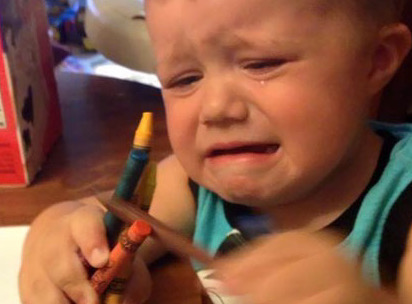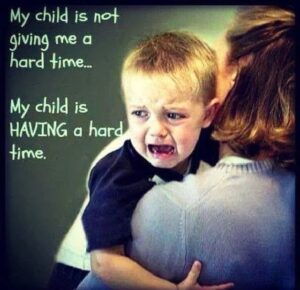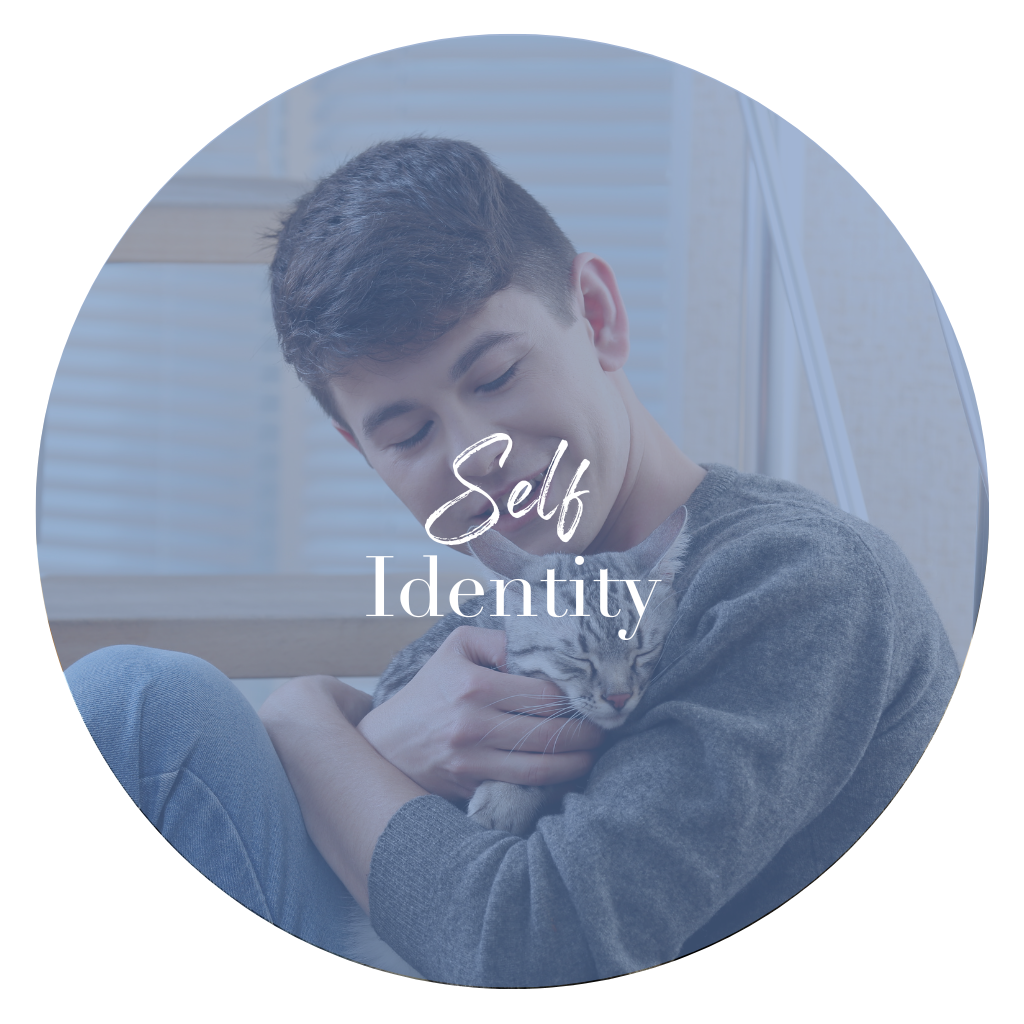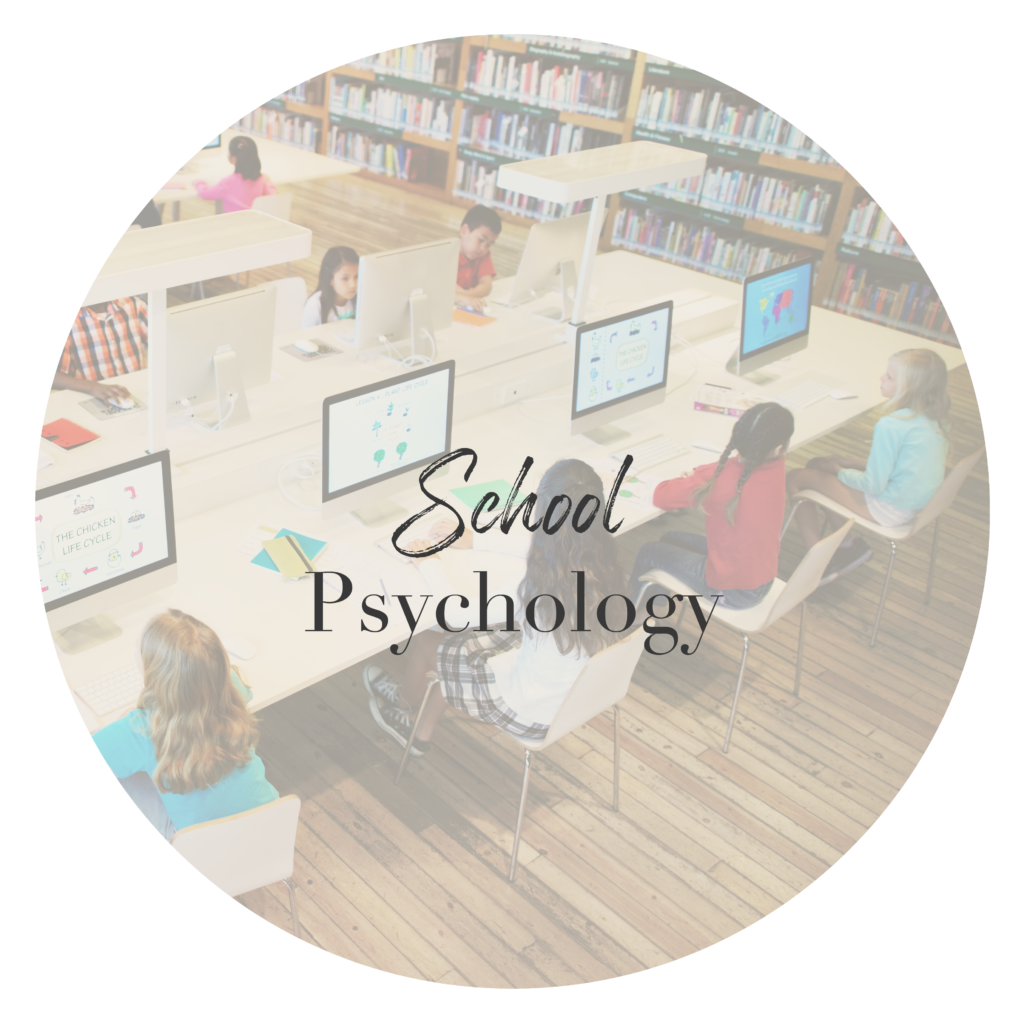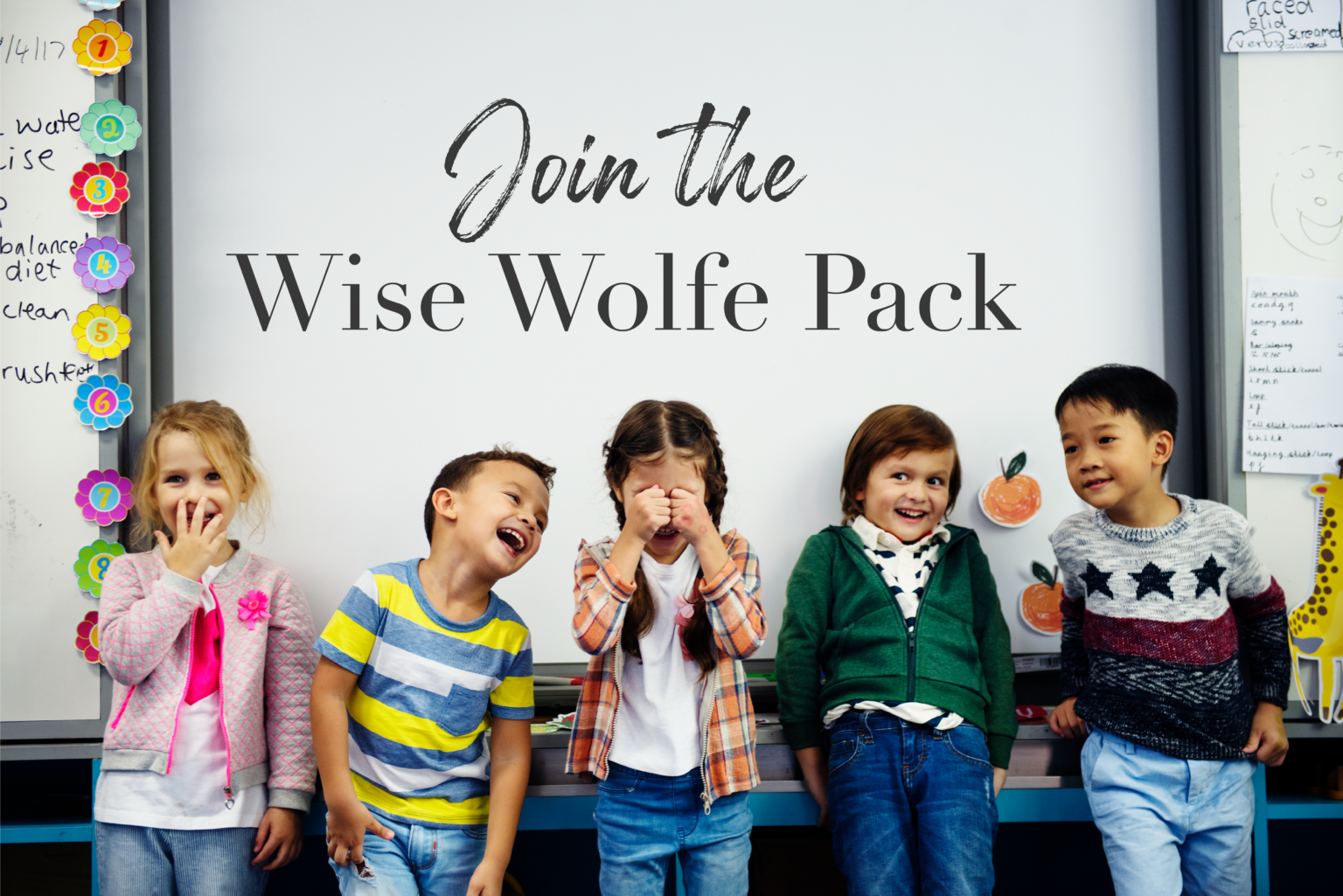What? Tantrums… at what age?! Why tantrums deserve our respect.
WILL
Unfortunately, to tantrum is natural and normal for preschoolers. Tantrums are actually a very important mechanism of emotional development. If preschoolers are not having tantrums, AT ALL, that is a reason to worry. It’s a worry because we are all born with a strong ‘will’. We have a ‘will’ to live, a ‘will’ to Attach, and a ‘will’ to learn, do, interact, understand, and explore. ‘Will’ is willful, giving us the intestinal fortitude, to make our way in a world fraught with obstacles. However, young children can erupt like a volcano, when ‘will’ outweighs skill. I recently marveled at my niece taking care of her six-month old infant, who was snuggled into a Kangaroo Baby Carrier. The infant was facing away from mom and was quite happy to engage with others in the room. If the infant got fussy, mom was fully supplied with toys and bottles, which would magically appear over the infant’s right shoulder. This wonderful mom could decide instantly what the child needed and react just as quickly to cues of what was rejected, to keep the infant content. Dad was also nearby and without a break in conversation, he wiped away teething drool and fluffed his infant’s hair affectionately. With attention, food, and toys appearing out of nowhere, it’s no wonder young children believe in magic!
EARLY LANGUAGE
From the earliest ages, we know what our infant needs before they do, because their needs are pretty basic. As this infant grows, their basic needs remain largely predictable, but their wants and interests expand. Yet, without language they can’t clearly communicate what they’re fussing about and adults can guess wrong. So, when infants have the ‘will’ to communicate before they have the skill for language, emotions can erupt. There is interesting research on teaching infants rudimentary sign language, so they can ‘sign’ toy, mom, dad, or food, for example. Skill in signing or using gestures, develops earlier than spoken language. Research into developmental advantages to babies who ‘sign’ is not widely conclusive (Mueller, et al, 2014), but some results indicate fewer tantrums and earlier spoken language. Babies who can ‘sign’ don’t have to be overtly willful by crying and fussing, to get what they want. Instead their ‘will’ is focused by an effort to use their skill in communicating. This still doesn’t explain why we should respect tantrums, but we’re getting there.
‘WILL’ EFFORT and CONTROL
I’m with you that tantrums are rough, tough to handle especially in public, and we would rather do without them. But ‘will’ giving way to effort and control, are developmental outcomes, so we all have to put in the developmental work. Also, these are emotional outcomes, so we have to put in the emotional development work, to gain effortful control. Unfortunately, we can talk to young children until we’re blue in the face, give time outs, and use consequences we think are appropriate, perhaps escalating consequences! But, if we don’t give time and space to emotional development – we get teens and adults who continue to tantrum. Tantrums in older children, teens, and adults look different, are more dangerous, and require different solutions (see blog post “From tantrums to ‘counterwill’: How emotional defenses get stuck for children, teens, and adults” Nov 2020).
PRESCHOOLERS
But about preschoolers; cognitive/behavioral approaches do not work when addressing emotional issues like tantrums. A cognitive approach relying on teaching lessons by talking, explaining, or planning to do better next time, disregards the root emotions at play with an out of control child, and so will not work. The three root emotions are alarm, frustration, and separation. It’s helpful to know about these root emotions because preschoolers’ tantrums occur at the intersection. Alarm requires emotional solutions, frustration requires developmental solutions, and separation requires relational solutions. You will see how we can use all three kinds of solutions at once, to live through tantrums. Adults are the agents of development for children in their care, meaning we respect tantrums as a mechanism for emotional growth, when we do three things at once. Specifically; we calm their big emotions, we name frustration so they feel this experience, and we stay present and attentive to this child to avoid separation in the moment. Think: it’s about emotions not cognition.
WILL
BEHAVIORISM Likewise a behavioral approach relying on consequences to teach a lesson, fails to respect our relationship with this child by introducing coercion, and so will not work. We have all been sold the snake oil of rewards and consequences by the Behaviorists (John Watson 1930-1958). Our parents parented this way and the teaching profession is still suffering from several un-examined assumptions of Behaviorism. The Science of Behaviorism rejected emotions as unimportant and inconvenient, then argued for not touching children! Current programs and publications based on behavioral approaches, are ignorant of emotional development (Minahan & Rappaport, 2012; Positive Behavior Intervention, 2020).
RELATIONAL DEVELOPMENT PARADIGM
In fact, a behavior/learning paradigm stands in stark contrast to a relational/developmental paradigm (Macnamara, 2016) and this is why an Attachment approach generates so many effective solutions, to age old problems like tantrums. Development is about readiness, so our timing has to be right. If we push for too much too soon, children will be more frustrated. This is true simply because effortful control is developmental and requires the ability to think twice or stop and think before acting. Preschoolers cannot think twice or stop and think. The good news is that adults can lead very young children through tantrums by scaffolding. Scaffolding is a useful concept for describing the role of adults, as agents of emotional development. Adults CAN organize a young child’s feelings (Powell et al, 2014) and support development of emotional awareness and effortful control, by scaffolding.
SCAFFOLDING
So, we’re going to scaffold toward the ability to think twice, or stop and think. This is less like scaffolding to build a wall and more like scaffolding to ride a wave. We will use our power of perception to feel this child’s emotional energy, build and subside, and look for body language inviting us back into relationship with them, to be hugged, then listen to our words. Sound tricky?
AGE 5-7 SHIFT
The good news is that if this child’s emotional development progresses as it should, our scaffolding will fade into obsolescence by the “age 5-7 cognitive shift” (White, 1965)). This shift has been better explained recently as a maturation switch point marked by hormone production (Del Guidice, M. & Belsky, J. 2010). Hormones at this age, stimulate sex differences in Attachment and brain growth, further providing the capacity to hold two thoughts or perspectives at once, a somewhat gendered perspective at that. The shift or switch point facilitates thinking twice and being able to stop and think, to master reflection. So to review; scaffolding manages tantrums in the moment, plus supports readiness for the “age 5-7 shift”, creating capacity for reflection. Reflection engages effortful control. Or let me use a current moniker: self-regulation.
AT SCHOOL
Tantrums ride an emotional wave. A child gains a tiny measure of maturity by living through the entire tantrum, to calmness on the other side. In our scaffolding we are setting a relational pattern. The pattern includes; calming the child’s big emotions, naming the emotion “frustration”, and remaining present and connected to the child in the moment. To extend the metaphor; scaffolding is erected ahead of time in preparation for a tantrum to build in emotional intensity. Once the first level of scaffolding is in place, the next level is ready. If the child gets emotionally stuck and the tantrum is not de-escalating, at least the lower scaffolding is stable. Next is more detail on scaffolding.
LIVING THROUGH A TANTRUM
(WolfeWisdom YouTube “Interventions, 2018) (Neufeld, 2015)
Tantrums call for mental health first aid so we will listen to the emotions rather than the words or actions. We spoil the developmental process if we interfere too much and we will certainly misread the emotions if we take any of this personally. Remember tantrums are part of being an immature person but also, they are not fun for the child either. Yet growth with effortful control is only possible, if this child can experience a tired body & spent temper, which comes on the down-side, as the aggressive energy de-escalates on its own. Resilience and a small measure of effortful control are very good outcomes, but these will only result from a tantrum that comes to its own de-escalation.
1. Depersonalize the tantrum by not being emotionally reactive yourself and avoiding eye contact. Because, unfortunately tantrums are a natural occurrence, as emotional development progresses. Stay close by since proximity with this child will keep them safe & safeguard the relationship by validating the frustration. Taking control by trying to interrupt the tantrum will be unproductive and usually escalates the aggressive energy. It’s best not to say anything until the aggressive energy dissipates. Discipline, yelling, staring down, or moving the child is not appropriate.
2. Convey the relationship can take the weight of the tantrum by being there in the moment when the energy subsides “are you OK? Are you hurt?”
3. NAME the emotion: “wow that was big frustration, so frustrating, big emotions of frustration”
4. Slow down now so the child can FEEL the frustration: the child doesn’t necessarily have to comment and agree that this is frustration, but it’s important they don’t argue with you and continue to tantrum. The tantrum is the raw emotion and as long as it continues – this child is avoiding feeling. They need to feel before they can mix.
5. MIX with caring or curiosity “I care about this frustration, I am curious about this frustration” and you will know pretty much right away, if this child is open to feelings of caring or curiosity, meaning they are ready to stretch toward reflection.
6. REFLECT: We climb the scaffolding toward reflection by reviewing; “are you hurt? that is huge frustration, I care about frustration, I am curious about this frustration”. When the preschooler is completely calm, even if they have very little language yet, talk with a soothing voice to explain “I will help you”. Hold your child, take them into another room, or take a walk.
When kids have spoken language: We are hoping for spontaneous statements of self-caring and curiosity about how/why the frustration is so big. Often kids will launch into deflecting or blaming “she hit me first, she took my stuff”. However, we are not going to enter into this child’s reality and also not impose our reality of right & wrong, we are going to attempt to talk about the frustration first. “that’s big frustration, I care about big feelings.” As adults we don’t have to know precisely how to help this child reflect as long as they stay in the conversation to explore the emotions erupting into feelings of frustration.
There can be strong resistance to reflect on big emotions, so we often have to wait 24-48 hours before this child is far enough away from the incident to be able to reflect. We can capture the memory of the big emotions without causing a relational disconnect or feelings of shame, if we wait.
UNDER-CONTROL and OVER-CONTROL
Reflection is foundational to self-regulation. Self-regulation is not just behavior, it is a developmental outcome. If we are gentle with scaffolding before the “age 5-7 shift” then children use reflection sooner rather than later. If we are not gentle and too quick to anger, use consequences instead of calming, or be impatient, then the outcome will be children who suffer with under-controlled emotions or over-controlled emotions. Both are undesirable. Under-control is externalized emotions like; aggression, defiance, and other antisocial behavior. Over-control is internalizing like; anxiety, social withdrawal, and lack of confidence. Habitual under-control and over-control of emotions are not good outcomes. Flexible emotional control is best and can be achieved over several preschool years with gentleness at the intersection of emotions, relationship, and development.
AT SCHOOL
It is plain dangerous when kids tantrum at school. So, adults have to be well prepared to take charge. Actually, most children outgrown tantrums before they begin school. But, when emotional development is lagging, or this child is extra emotionally intense, tantrums can characterize their emotional coping for longer. If this is the case, we need mental health first aid, in two forms. First, we need safety back-up plans at school (WolfeWisdom YouTube E-fRD Interventions, 2018) and we also need parents to facilitate tantrums at home by scaffolding to reflection. Facilitate probably doesn’t sound very pleasant, but the problem is that tantrums have developmental facility, they are useful developmentally. If a child has a pattern of tantrums, we have no choice but to set a new pattern, come alongside to keep the child safe, and take advantage of any emotional growth by scaffolding. We are actually respecting the human developmental journey by scaffolding emotional support for alarm, frustration, and separation. Over my four decades in schools, I have found that when parents facilitate tantrums at home with the scaffolding outlined above, this creates the time and space for their child’s aggressive energy to be relieved. Growing up is challenging and frustrating! If tantrums are always interrupted and kids are told “that is inappropriate, stop that”, then where is the space for emotional growth?
ADULTS ARE AGENTS OF DEVELOPMENT
We can appreciate why its valuable to respect preschool tantrums, when we see our role as an agent of emotional development. Children do better when there is emotional readiness for a challenging environment like school. Fewer tantrums in school keeps everyone safer. Yet, the best outcome is even longer term. We get teens and adults with greater emotional awareness, relational capacity, and developmental competence. Our efforts with emotions, relationships, and development, create a more collaborative and peaceful future. (see blog post “From tantrums to ‘counterwill’: How emotional defenses in children, teens, and adults can get stuck… and unstuck.” Nov 2020).
REFERENCES
Del Giudice, M. & Belsky, J (2010). Sex differences in attachment emerge in middle childhood: An evolutionary hypothesis. Child Development Perspectives, 4(2), 97-105. Mueller, V. Sepulveda, A. & Rodriguez, S. (2014). The effects of baby sign training on child development, Early Child Development and Care, 184:8, 1178-1191, DOI: 10.1080/03004430.2013.854780 Macnamara, D. (2016). Rest Play Grow: Making sense of preschoolers or anyone who acts like one. Vancouver, Canada: Aona Books. Neufeld, G. (July, 2015). Challenging childhood problems. Vancouver workshop. Watson, J.B. (1930). Behaviorism. London: Kegan Paul, Trench, Turner & Co., Ltd.

